Experimental SHPB Study of Limestone Damage under Confining Pressures after Exposure to Elevated Temperatures
Abstract
:1. Introduction
2. Specimen Preparation and Testing Procedure
2.1. Experimental Equipment
2.2. SHPB Experimental Principle
2.3. Data Validity Verification
2.4. Experimental Materials and Scheme
3. Experimental Results and Analysis
3.1. Experimental Results
3.2. The Effects of High Temperature on Dynamic Mechanical Properties
3.3. The Effects of Confining Pressure on the Dynamic Mechanical Properties of Limestone after High-Temperature Treatment
3.4. The Dynamic Damage Constitutive Model for Limestone under the Action of Confining Pressure after High-Temperature Treatment
- i.
- The impact of the acceleration of gravity on the constitutive relation of rock can be neglected;
- ii.
- The damage and viscosity of the rock’s differential element and the performance of the elastomer can be considered isotropous;
- iii.
- Before the occurrence of damage, the differential element shows elastic properties and satisfies Hooke’s Law;
- iv.
- The constitutive relation of the viscous element satisfies the following:
- v.
- The strength of the differential element has a Weibull distribution [26]; i.e., the density function satisfies the following:
4. Conclusions
Author Contributions
Funding
Data Availability Statement
Conflicts of Interest
References
- Xie, H.P.; Zhou, H.W.; Xue, D.J.; Wang, H.W.; Zhan, R.; Gao, F. Research and thinking on deep mining and limit mining depth of coal. J. China Coal Soc. 2012, 37, 535–542. [Google Scholar]
- Xie, H.P. Research conception and prospect of “deep rock mechanics and mining theory”. Adv. Eng. Sci. 2017, 49, 1–16. [Google Scholar]
- Wang, S.M.; Sun, Q.; Qiao, J.W.; Wang, S.Q. Discussion on the geological guarantee of green mining of coal. J. China Coal Soc. 2020, 45, 8–15. [Google Scholar]
- Zhao, G.Y.; Qiu, J.; Yuan, Z.; Pei, D.; Yang, L.; Pan, W. Discussion on evaluation method of green mining of metal. Gold Sci. Technol. 2020, 28, 169–175. [Google Scholar]
- Mauko, A.; Fíla, T.; Falta, J.; Koudelka, P.; Rada, V.; Neuhäuserová, M.; Zlámal, P.; Vesenjak, M.; Jiroušek, O.; Ren, Z. Dynamic Deformation Behaviour of Chiral Auxetic Lattices at Low and High Strain-rates. Metals 2020, 11, 52. [Google Scholar] [CrossRef]
- Fu, H.; Wang, X.; Xie, L.; Hu, X.; Umer, U.; Rehman, A.U.; Abidi, M.H.; Ragab, A.E. Dynamic Behaviors and Microstructure Evolution of Iron–nickel Based Ultra-high Strength Steel by Shpb Testing. Metals 2019, 10, 62. [Google Scholar] [CrossRef] [Green Version]
- Klepaczko, J.R. Behavior of rock-like materials at high strain rates in compression. Int. J. Plast. 1990, 6, 415–432. [Google Scholar] [CrossRef]
- Cherouat, A.; Borouchaki, H.; Jie, Z. Simulation of Sheet Metal Forming Processes Using a Fully Rheological-damage Constitutive Model Coupling and a Specific 3d Remeshing Method. Metals 2018, 8, 991. [Google Scholar] [CrossRef] [Green Version]
- Lei, B.; Chen, G.; Liu, K.; Wang, X.; Jiang, X.; Pan, J.; Shi, Q. Constitutive Analysis on High-Temperature Flow Behavior of 3Cr-1Si-1Ni Ultra-High Strength Steel for Modeling of Flow Stress. Metals 2019, 9, 42. [Google Scholar] [CrossRef] [Green Version]
- Li, X.B.; Gu, D.S.; Lai, H.H. Reasonable loading waveform in dynamic stress-strain map test of rock under impact load. Explos. Shock. Waves 1993, 2, 125–130. [Google Scholar]
- Ping, Q.; Ma, Q.Y.; Lu, X.Y.; Yuan, W. Study on impact compression test of rock materials under passive confining pressure. J. Vib. Shock. 2014, 33, 55–59. [Google Scholar]
- Xiao, M.; Ma, D.D.; Hu, D.W.; Zhou, H.; Chen, S.L.; Yu, Z.P.; Tan, X.F. Development and application of high temperature true triaxial test system in real time. Chin. J. Rock Mech. Eng. 2019, 38, 1605–1614. [Google Scholar]
- Li, M.; Mao, X.; Cao, L.; Pu, H.; Lu, A. Influence of Heating Rate on the Dynamic Mechanical Performance of Coal Measure Rocks. Int. J. Geomech. 2017, 17, 04017020. [Google Scholar] [CrossRef]
- Yin, T.; Li, X.; Xia, K.; Huang, S. Effect of Thermal Treatment on the Dynamic Fracture Toughness of Laurentian Granite. Rock Mech. Rock Eng. 2012, 45, 1087–1094. [Google Scholar] [CrossRef]
- Fakhimi, A.; Azhdari, P.; Kimberley, J. Physical and Numerical Evaluation of Rock Strength in Split Hopkinson Pressure Bar Testing. Comput. Geotech. 2018, 102, 1–11. [Google Scholar] [CrossRef]
- Mishra, S.; Chakraborty, T.; Matsagar, V. Dynamic Characterization of Himalayan Quartzite Using SHPB. Procedia Eng. 2017, 191, 2–9. [Google Scholar] [CrossRef]
- Yin, Z.Q.; Li, X.B.; Jin, J.F.; He, X.Q.; Kun, D.U. Failure Characteristics of High Stress Rock Induced by Impact Disturbance Under Confining Pressure Unloading. Trans. Nonferrous Met. Soc. China 2012, 22, 175–184. [Google Scholar] [CrossRef]
- Zhu, J.; Hu, S.; Wang, L. An Analysis of Stress Uniformity for Concrete-like Specimens During Shpb Tests. Int. J. Impact Eng. 2009, 36, 61–72. [Google Scholar] [CrossRef]
- Ke, M.; Zhou, H. Dynamic Force Balance Analysis of SHPB System. Met. Mine 2010, 39, 27–30. [Google Scholar]
- Zhang, Z.X.; Yu, J.; Kou, S.Q.; Lindqvist, P.A. Effects of High Temperatures on Dynamic Rock Fracture. Int. J. Rock Mech. Min. Sci. 2001, 38, 211–225. [Google Scholar] [CrossRef]
- Ping, Q.; Wu, M.J.; Huan, Z.; Yuan, P. Experimental research on dynamic mechanical properties of sandstone under high-temperature condition. Chin. J. Undergr. Space Eng. 2019, 15, 691–698. [Google Scholar]
- Yin, T.B.; Shu, R.H.; Li, X.B.; Pin, W.A.; Dong, L.J. Combined Effects of Temperature and Axial Pressure on Dynamic Mechanical Properties of Granite. Trans. Nonferrous Met. Soc. China 2016, 26, 2209–2219. [Google Scholar] [CrossRef]
- Shu, R.H.; Yin, T.B.; Li, X.B.; Yin, Z.Q.; Tang, L.Z. Effect of heat-treatment on energy dissipation of granite under cyclic impact loading. Trans. Nonferrous Met. Soc. China 2019, 29, 158–169. [Google Scholar] [CrossRef]
- Shi, L.; Xu, J. Effect of Strain Rate on the Dynamic Compressive Mechanical Behaviors of Rock Material Subjected to High Temperatures. Mech. Mater. 2015, 82, 28–38. [Google Scholar]
- Yang, S.Q.; Yin, P.F.; Huang, Y.H.; Cheng, J.L. Strength, Deformability and X-ray Micro-ct Observations of Transversely Isotropic Composite Rock Under Different Confining Pressures. Eng. Fract. Mech. 2019, 214, 1–20. [Google Scholar] [CrossRef]
- Kasyap, S.S.; Li, S.; Senetakis, K. Investigation of the Mechanical Properties and the Influence of Micro-structural Characteristics of Aggregates Using Micro-indentation and Weibull Analysis. Constr. Build. Mater. 2020, 271, 121509. [Google Scholar] [CrossRef]
- He, A.; Wang, Z.; Bi, C. Experimental study on thermal damage characteristics and mechanism of Huashan granite. Hydro-Sci. Eng. 2018, 1, 95–101. [Google Scholar]
- Krajcinovic, D.; Silva, M.A.G. Statistical Aspects of the Continuous Damage Theory—Science direct. Int. J. Solids Struct. 1982, 18, 551–562. [Google Scholar] [CrossRef]
- Yin, T.; Wang, P.; Yang, J.; Li, X. Mechanical Behaviors and Damage Constitutive Model of Thermally Treated Sandstone Under Impact Loading. IEEE Access 2018, 6, 72047–72062. [Google Scholar] [CrossRef]
- Zhou, J.; Yang, X.; Li, H. Numerical Solution for Mixed Mode Crack Propagation in Brittle Solids Combined with Finite Element Method and Failure Criteria. Int. J. Mater. Prod. Technol. 2012, 45, 96–107. [Google Scholar] [CrossRef]
- Shi, X.; Zhou, W.; Chen, L.; Cai, Q.; Li, M.; Li, Z.; Luan, B. A New Unified Solution for Circular Opening Considering Different Strength Criteria and the Postpeak Elastic Strain Form. Adv. Civ. Eng. 2020, 2020, 1–21. [Google Scholar] [CrossRef]
- Peng, J.; Tang, Z.C.; Hou, D. A Gsi-softening Model for Characterizing Strength Behavior of Thermally-damaged Rock. Eng. Geol. 2021, 292, 106251. [Google Scholar] [CrossRef]
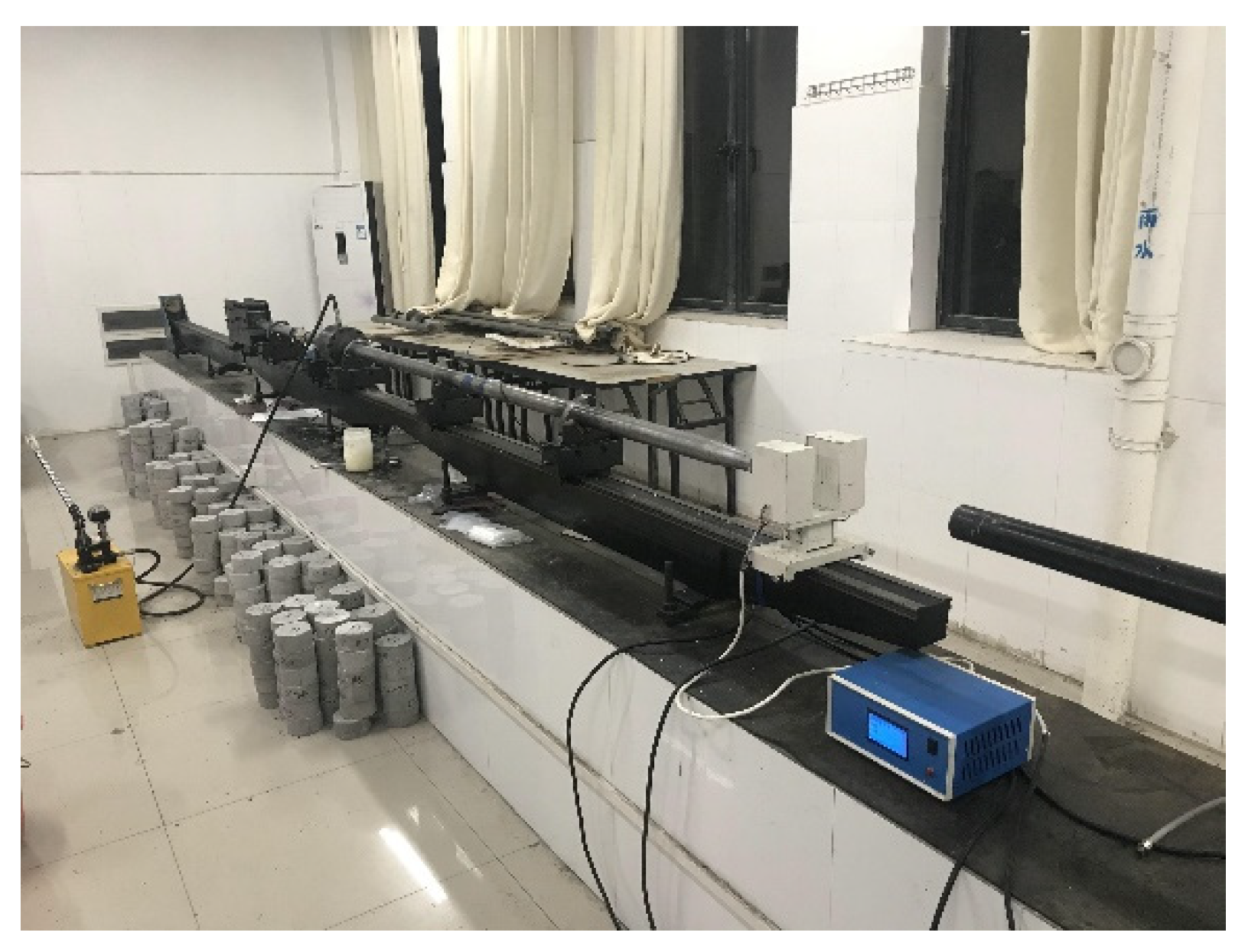

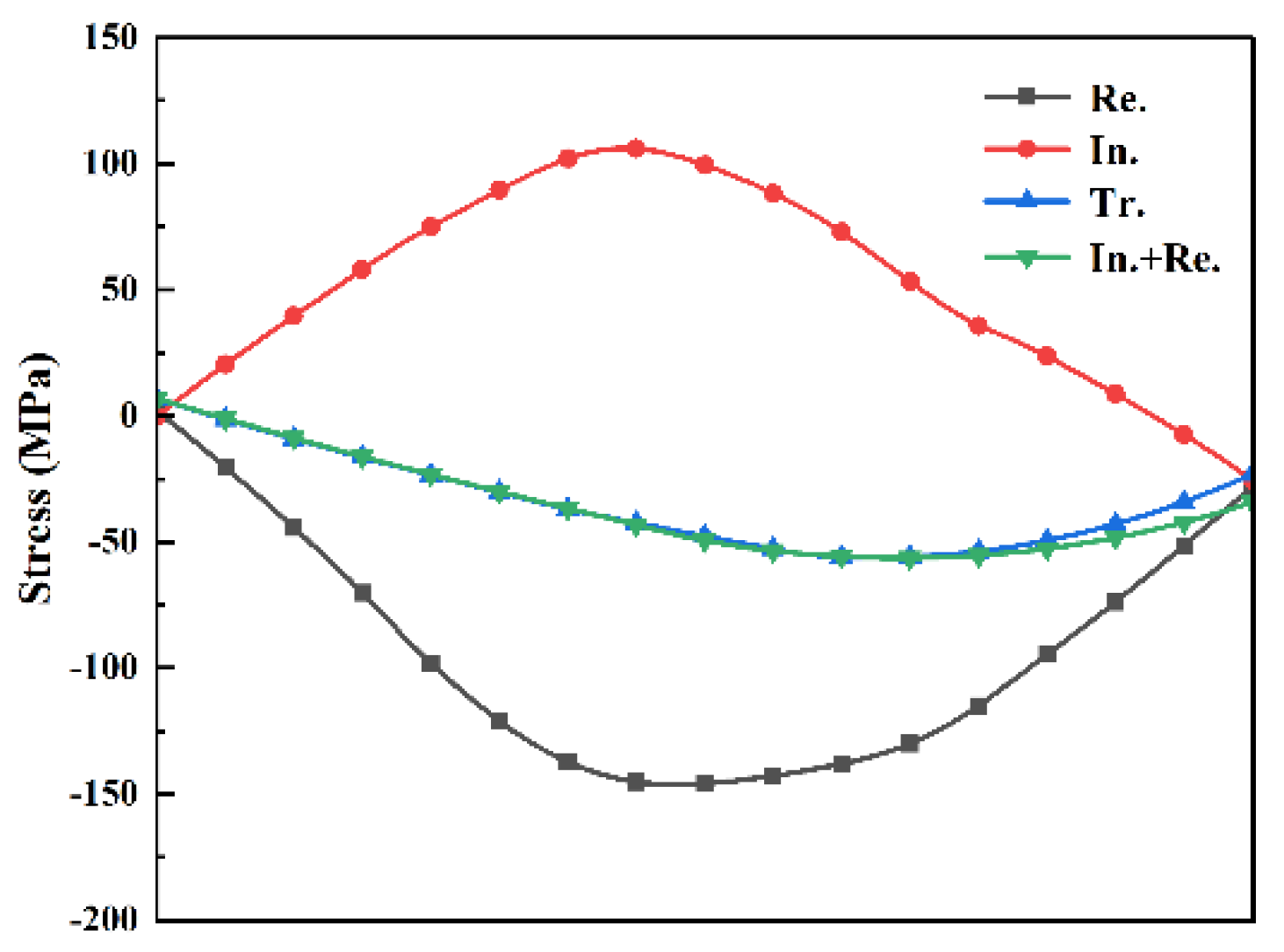

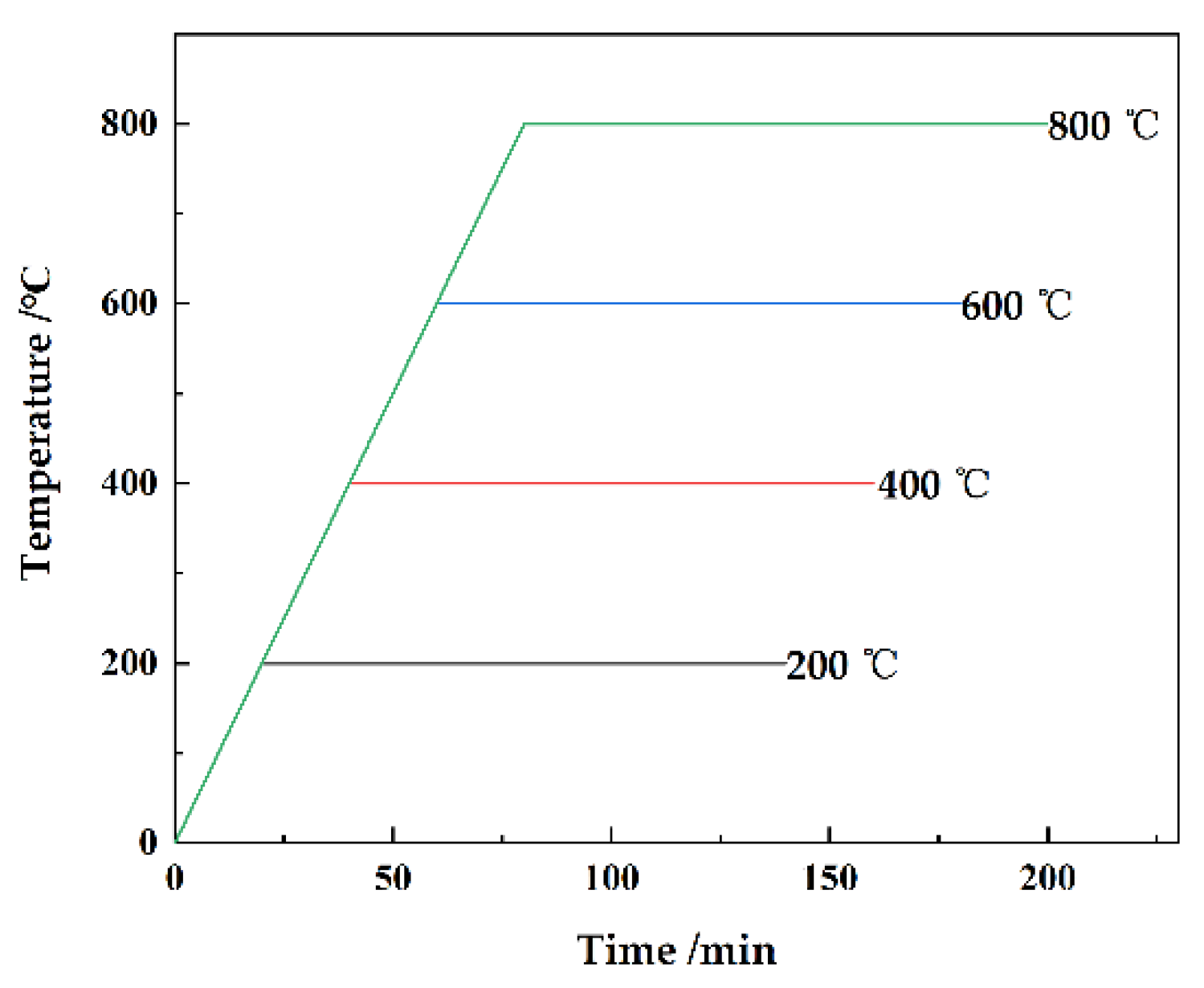


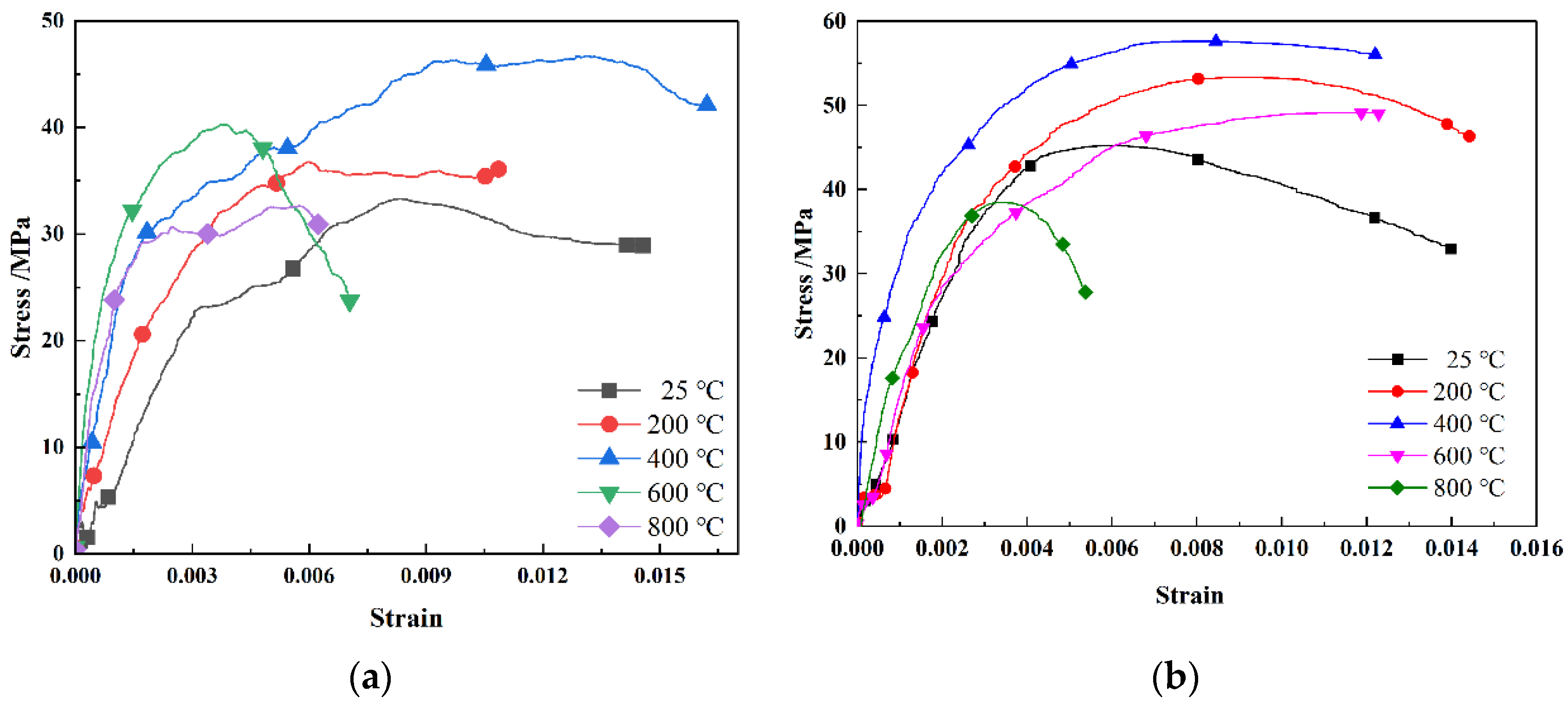
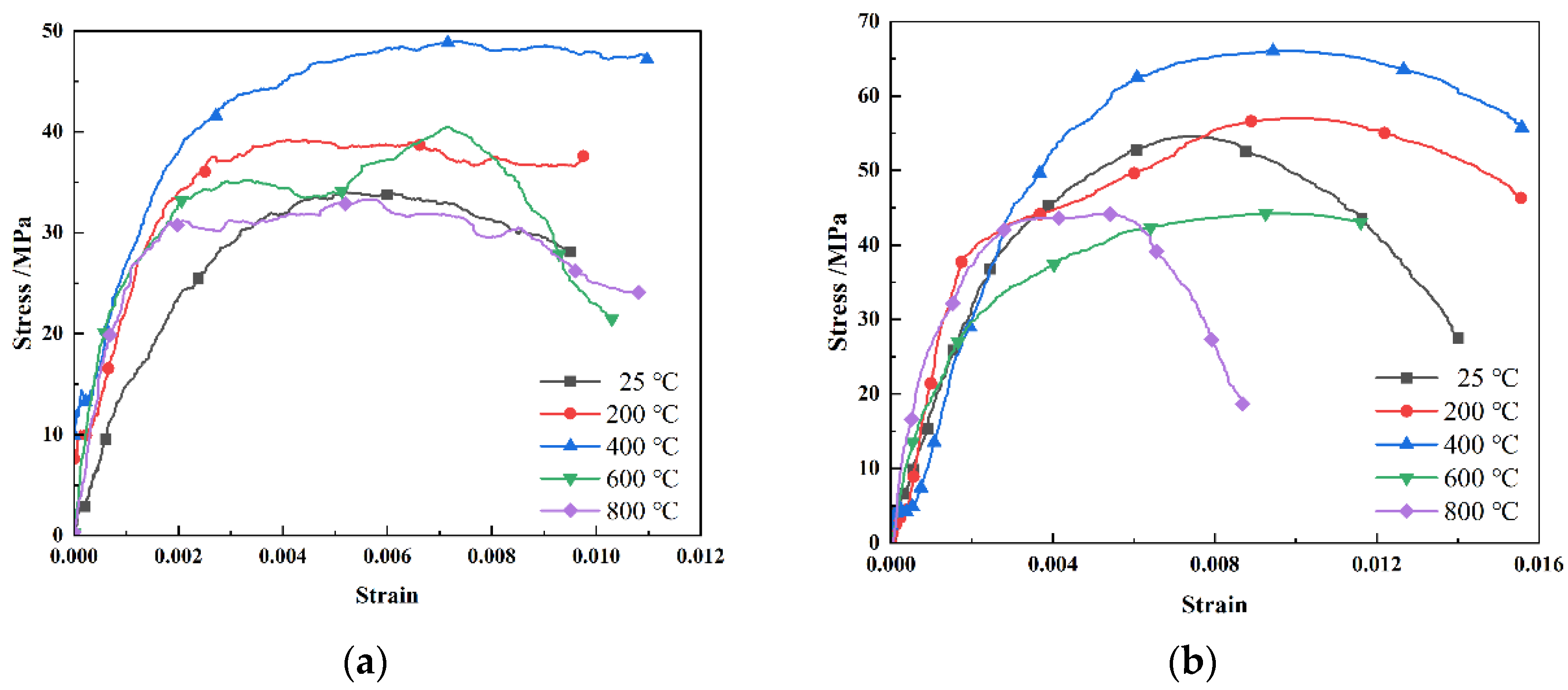

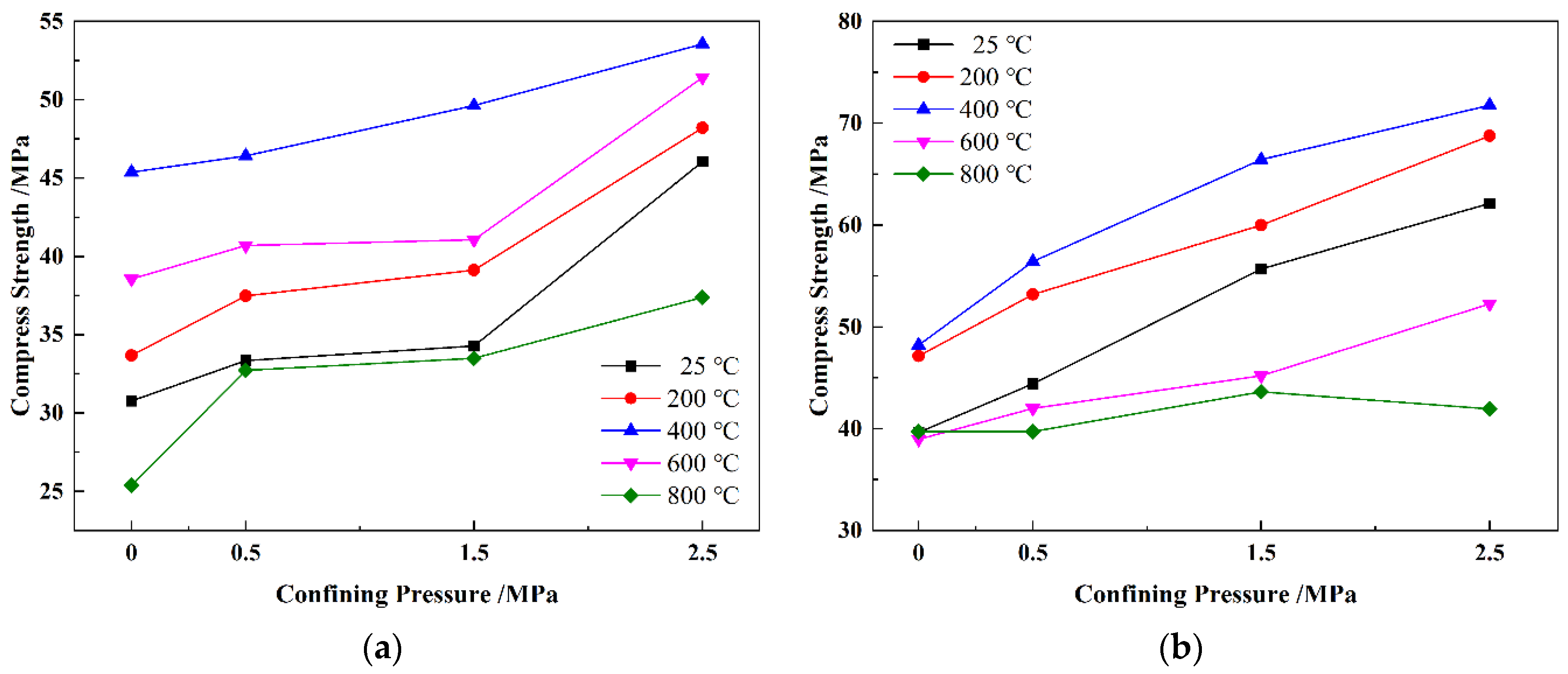

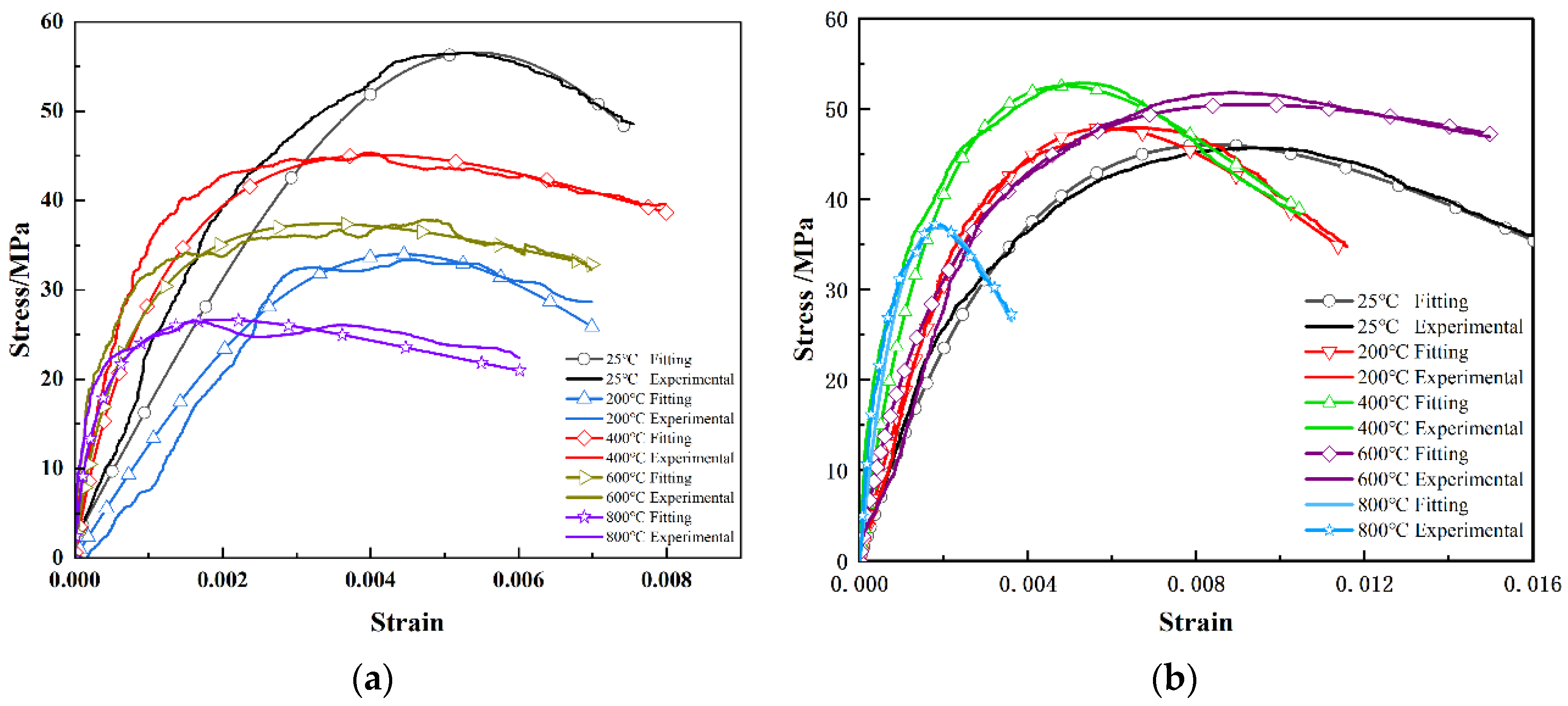
| Impact Velocity (m/s) | Confining (MPa) | Temperature (°C) | Compressive Strength (MPa) | Peak Strain ×10−3 | Elastic Modulus (GPa) |
|---|---|---|---|---|---|
| 5.3 | 0 | 25 | 30.78 | 28.9 | 15.6 |
| 200 | 33.68 | 28.1 | 16.83 | ||
| 400 | 45.37 | 32.6 | 17.55 | ||
| 600 | 38.56 | 34.5 | 22.03 | ||
| 800 | 25.38 | 37.9 | 19.65 | ||
| 0.5 | 25 | 33.35 | 2.72 | 7.65 | |
| 200 | 37.49 | 3.52 | 12.6 | ||
| 400 | 46.42 | 4.66 | 14.38 | ||
| 600 | 40.71 | 5.24 | 18.55 | ||
| 800 | 32.72 | 5.51 | 14.7 | ||
| 1.5 | 25 | 34.28 | 3.06 | 11.6 | |
| 200 | 39.13 | 5.48 | 20.11 | ||
| 400 | 49.63 | 5.74 | 18.37 | ||
| 600 | 41.06 | 4.62 | 28.5 | ||
| 800 | 33.50 | 7.46 | 23.91 | ||
| 2.5 | 25 | 46.06 | 4.11 | 11.39 | |
| 200 | 48.20 | 5.91 | 14.9 | ||
| 400 | 53.56 | 7.88 | 24.16 | ||
| 600 | 51.42 | 8.82 | 11.97 | ||
| 800 | 37.39 | 8.89 | 13.66 | ||
| 8.6 | 0 | 25 | 39.63 | 48.8 | 19.72 |
| 200 | 47.13 | 73.3 | 16.52 | ||
| 400 | 48.20 | 48.8 | 16.33 | ||
| 600 | 38.95 | 56.2 | 19.26 | ||
| 800 | 39.73 | 54.2 | 15.24 | ||
| 0.5 | 25 | 44.42 | 3.41 | 10.23 | |
| 200 | 53.20 | 6.03 | 14.44 | ||
| 400 | 56.42 | 6.31 | 13.31 | ||
| 600 | 49.99 | 8.88 | 15.33 | ||
| 800 | 39.73 | 9.31 | 18.47 | ||
| 1.5 | 25 | 55.70 | 4.5 | 16.32 | |
| 200 | 59.99 | 7.97 | 21.56 | ||
| 400 | 66.42 | 8.2 | 14.77 | ||
| 600 | 45.19 | 8.87 | 10.57 | ||
| 800 | 43.63 | 10.91 | 23.11 | ||
| 2.5 | 25 | 62.136 | 3.76 | 11.31 | |
| 200 | 68.778 | 5.31 | 18.78 | ||
| 400 | 71.778 | 8.52 | 19.43 | ||
| 600 | 49.280 | 6.16 | 17.18 | ||
| 800 | 31.945 | 13.01 | 21.31 |
Publisher’s Note: MDPI stays neutral with regard to jurisdictional claims in published maps and institutional affiliations. |
© 2021 by the authors. Licensee MDPI, Basel, Switzerland. This article is an open access article distributed under the terms and conditions of the Creative Commons Attribution (CC BY) license (https://creativecommons.org/licenses/by/4.0/).
Share and Cite
Liu, L.; Li, R.; Qin, H.; Sun, W. Experimental SHPB Study of Limestone Damage under Confining Pressures after Exposure to Elevated Temperatures. Metals 2021, 11, 1663. https://doi.org/10.3390/met11101663
Liu L, Li R, Qin H, Sun W. Experimental SHPB Study of Limestone Damage under Confining Pressures after Exposure to Elevated Temperatures. Metals. 2021; 11(10):1663. https://doi.org/10.3390/met11101663
Chicago/Turabian StyleLiu, Lei, Rui Li, Hao Qin, and Wei Sun. 2021. "Experimental SHPB Study of Limestone Damage under Confining Pressures after Exposure to Elevated Temperatures" Metals 11, no. 10: 1663. https://doi.org/10.3390/met11101663
APA StyleLiu, L., Li, R., Qin, H., & Sun, W. (2021). Experimental SHPB Study of Limestone Damage under Confining Pressures after Exposure to Elevated Temperatures. Metals, 11(10), 1663. https://doi.org/10.3390/met11101663






